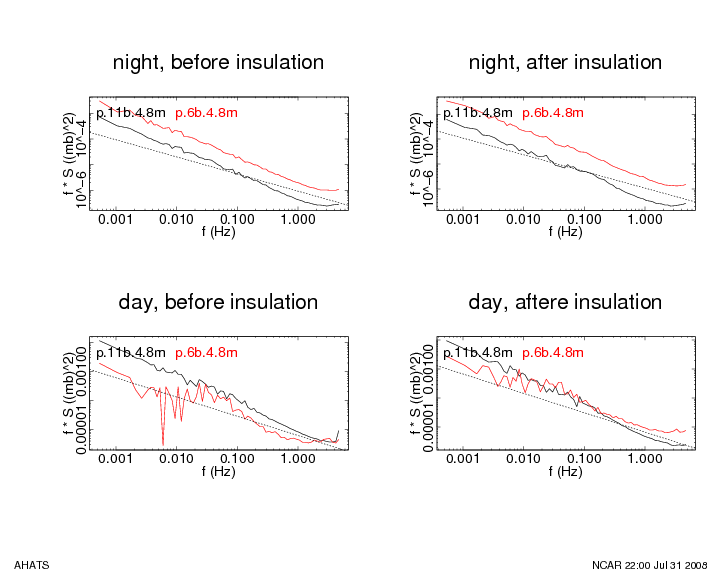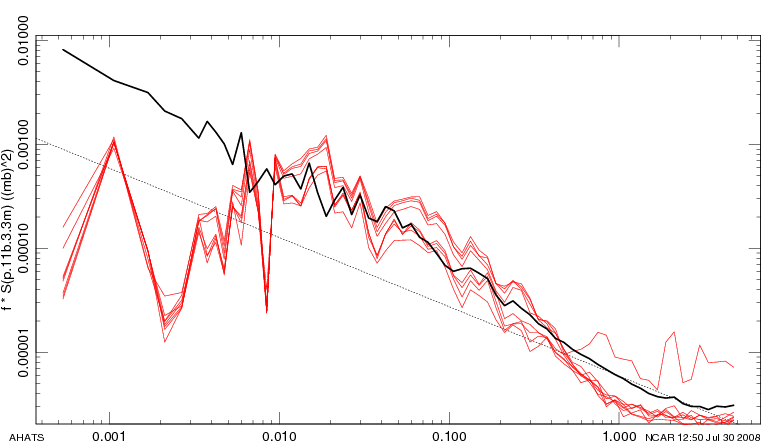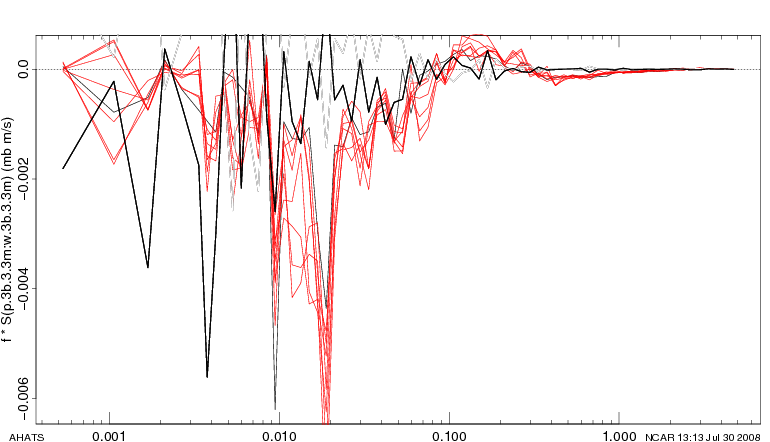After discussions with John Wyngaard over the last 2 days (and a wake-up call this morning), we decided to try to lower at least the high frequency fluctuations in Pref by trying to add a sleeve around the tubing. John had the great idea to use foam pipe insulation. We found some in Hanford and added it to the horizontal sections of the array when it was down for sonic leveling today. Unfortunately, I had only purchased enough for a test this morning, so we were one piece short (between 7t and 8t) and only did the vertical run between 5b and 5t. I now have more insulation and will add it first thing tomorrow. I'll try to add a P.S. tonight to see if there is any effect on the spectra.
Note that at 1140, I opened up the reference tubing to re-route a piece near 5b.
P.S. Spectra from yesterday (7/30) and today (7/31) at 17:00 and 21:00 show that there is some modest improvement even with only this partial tubing. (In these plots, 11b is Pref and 6b is p-Pref.) We'll see tomorrow when the rest are done.
Today, since the winds were too easterly and since we wanted to work on the pressure tubing anyway, we lowered both horizontal arrays to adjust the sonics to be more level. We dropped the east array ~1030 and worked on it until ~1400. We then dropped the west array and worked on it until ~1700. A long, hot, day...
I now estimate that the heights of these sonics are within +/- 3cm of each other and with the upwind sonics. The most different sonics are now the fixed ones on the profile mast. This is at least a factor of 5 better than they were. Moreover, they are now close to level. (I'll try tilt plots when I get a chance.)
We accomplished this feat by:
0. Lowering the array to the ground
1. Moving the 1/2" EMT conduit to below the booms, rather than on top
2. Connecting the EMT pieces with the dowel in the middle and with EMT screw couplers
3. Drilling holes in the EMT to accomodate S-hooks at 4 places (not evenly spaced due to flex in the EMT).
4. Attaching short guywire pieces (used to extend the former upwind guys) to the EMT
5. Attaching ratchet straps to each pair of guywires on the bottom array that was secured to the top array ASTER tower
6. Lifting the horizontal array back in place.
7. Attaching ratchet straps to each pair of guywires on the top array to the top crosspiece of the H-frame support.
We're pretty pleased with ourselves and only wish that we'd done this in CHATS!
Note that it is quite likely that at least some of the boom angles are different now. We'll reshoot everything sometime soon. Note that we think that the last (twh: first?) 2 days in config3 could use the config2 boom angles, since these sonics should not have shifted direction.
P.S. 2 examples of sonic tilts:
|
lean,azimuth [before] |
lean,azimuth [after] |
|---|---|---|
1b.4.8m |
4.0, -14 |
0.2, -124 |
3b.4.8m |
1.4, +30 |
1.7, +141 |
Note that 1b is at the end and 3b is the middle of the east array. The middle has become almost perfect. The end is different from vertical by the same amount, but is now in the opposite direction (in pitch angle). The difference between them actually hasn't changed much: 3.8 before and 3.1 after.
How to verify the ADAM GPS units are getting satellite lock via Gordon feedback
FYI, "ntpq -p" from aster is a good check of the network and GPS's. This shows
that all the adams are happy (with either a leading * or +) except for pressure2
which is getting its clock from the base.
[aster@aster ~]$ ntpq -p
remote refid st t when poll reach delay offset jitter
==============================================================================
+profile.isff.uc GPS_NMEA(0) 3 u 22 64 377 2.426 -0.319 1.428
*downwind1.isff. GPS_NMEA(0) 3 u 47 64 377 2.540 -0.255 1.270
+downwind2.isff. GPS_NMEA(0) 3 u 58 64 377 2.555 -0.171 0.677
+upwind.isff.uca GPS_NMEA(0) 3 u 22 64 377 2.547 -0.141 6.876
+pressure1.isff. GPS_NMEA(0) 3 u 39 64 377 2.437 -0.257 0.375
pressure2.isff. 192.168.13.1 5 u 2 64 377 2.538 0.126 2.289
LOCAL(0) .LOCL. 10 l 46 64 377 0.000 0.000 0.002
Here is an example from yesterday (1700-1730) of spectra (top panel) and cospsectra (bottom). The black line in the top panel is the spectrum of just the reference pressure (not connected to the atmosphere in any way). The red lines are all the sensors at 5m. Low frequencies in the reference pressure are due to drift in the CHATS reference volume due to changing soil temperature. Note that the signal-to-noise ratio from 0.01 to 1 Hz is on the order of one. (Actually, much better that the factor of 10 I've seen earlier in this case.) Also note that the high frequencies appear to be dominated by instrument noise for frequencies above 1Hz. Unfortunately, this is the frequency range of the subgridscale fluctuations.
The bottom panel has the w'p' cospectra for all of the 5m sensors (no significance to the color change -- sorry). The thick black line again is w'p' cospectrum of the reference pressure. It has noise, but definitely is a smaller signal than for real pressure. Note the "ringing" (change from - to +) at high frequencies that looks like a phase lag. I played with the data a bit and found that It would take about a 2 second lag to replicate this. I have no idea how such a lag could get into our system.
pressure2 crashed sometime after 7am. I revived it a bit after 9am. Cause unknown, but Steve was out there and may have knocked a cable.
The farm baled up the alfalfa from the fields to the east of our site yesterday. They were stacked in piles ~6m high (I took some photos) as of the start of config 3 ops. They were along the n-s road (on the east side of the irrig ditch) , from 1miles to 2miles north. The bales were moved to the corner 2 miles to the north this morning.
The config3 transition yesterday went:
1. Move the east horiz array up 3 slots. (This measured at ~4.87m for the top of 5b's boom to the base plate.) [started ~0600]
2. Move the west horiz array up 3 slots.
3. Move 6t and 6b up.
4. Move 12b up.
5. Move 5.5m and 4.3m up to ~5.8m and ~4.8m (also T/RHs) [done by 0830]
6. Tear-down upwind and move to staggered upwind, sequence 11u -> 3u [done by 1230]
7. Remove upwind bases [1530-1630]
When we started to build config 3, we measured 3.254m from the config 3 reference line to the top of 5b's boom (of course, after raising it to its position). New measurements for other sensors:
6t: 3.252m
6b: 3.250m
12b: 3.275m
(I didn't record new measurements of the 2 profile sensors.)
All of the upwind sensors were set to 3.261 = 3.254+0.7 to the top of the clamp +/-1mm.
P.S. The reference height mark #3 is 15.2cm below the mark for #2.
P.P.S. Some spacings:
5t 133.4cm 6t 127.4cm 7t
5b 133.7cm 6b 127.8cm 7b
11b 128.3cm 12b 132.0cm 13b
Tom asked us to remeasure heights of the config2 upwind array as we tore it down yesterday:
3 |
191.1 |
4 |
190.8 |
5 |
190.8 |
6 |
193.7 |
7 |
191.7 |
8 |
191.9 |
9 |
191.3 |
10 |
192.2 |
11 |
192.6 |
There were some stray marks on the towers. I wouldn't rule out the possibility that we chose the wrong reference line on some of the towers (note the the marks ended up underneath the masts sometimes). In particular, I wonder if 6u's measurement was wrong.
Also note that we ended up measuring to the top of the clamp, rather than the top of the boom since this was much easier to get to. The values above all have had an additional 0.7cm subtracted to compensate for this.
P.S. On x-spacing:
Distance from end of boom bracket to center of PAM (square) mast, which was aligned to stakes: 12.4cm
Distance from end of boom bracket to center of horiz array base plate, which was aligned to stakes: ~9cm
Distance between upwind stake line and horiz array stake line: was supposed to be 5.16m.
Distance between end of boom bracket to center of sonic arrays: ~177.7cm [but should be the same for either upwind or horiz array]
Thus, distance between upwind sensors and horiz array sensors: 5.16m + 12.4cm - 9cm = 5.13m.
Note that config 3 x-spacing should be the same.
We changed from config 2 to config 3 between 0600-1230 today. There still are a few PAM tripod bases left from config 3, so the surface is rougher than it should be. We'll remove them this afternoon after a well-deserved lunch!
P.S. John Wyngaard and Roger Wakimoto are now here as well.
I've looked a bit at the data from the 8m sonic. I plotted u,v,w components from 7m&8m as a function of wind direction. If the etherant were causing flow distortion, I would expect a signature that depends on wind direction. I also would expect vertical velocity to have a negative bias for winds into the array. What I see is u.8m being lower than u.7m, v.8m being equal to v.7m, and w.8m being higher than w.7m, all independent of wind direction. Thus, I do not believe that the etherant is the source of the low winds at 8m that we've been seeing.
The next step is to replace this sonic.
During the last 10 minutes, we swapped Pocketecs on upwind, downwind1, pressure2, and pressure1 (in that order). Obviously, there
will be brief data outages.
The pocketec units from profile and downwind2 were changed at about 12:45 local.
upwind stayed up with no hiccups overnight using the spare Viper board. Hopefully it is now fixed...
AHATS daily status 7/27/08
Staff: Semmer, Oncley, Nguyen, Tudor with ISS
Cohn visited yesterday.
Temps: 103F/66F yesterday
Again, a bi-daily report. Yesterday played with the pressure
system some more. Also have had upwind crashes every night.
For more details, see the ahats logbook at https://wiki.ucar.edu/display/ahatslogbook
Good wind direction: The standard function reports 53 hours (23
unstable, 30 stable) in this configuration, all but 3 segments shorter
than 2.5 hours. Note that our longest segment changed from 820 min
to 650 min now that I've entered boom angles -- a big change for only
a few degrees of reorientation! However we have had some sensors and
data systems down so the actual numbers would be lower.
Local data storage: (we're getting ready to download these)
------------------
upwind:/dev/sda1 57685532 8441508 49244024 15% /var/tmp/usbdisk
downwind1:/dev/sda1 57685532 11579060 46106472 20% /var/tmp/usbdisk
downwind2:/dev/sda1 57685532 13765456 43920076 24% /var/tmp/usbdisk
profile:/dev/sda1 57685532 7746824 49938708 13% /var/tmp/usbdisk
pressure1:/dev/sda1 3940812 2157556 1783256 55% /var/tmp/usbdisk
pressure2:/dev/sda1 3940812 2045904 1894908 52% /var/tmp/usbdisk
aster:/dev/sdb1 721075720 277274000 443801720 39% /media/isff2
isff:/dev/sdc1 1922890480 403213996 1421999280 23% /media/isff15
The isff3 backup disk should now be back in Colorado via Steve Cohn.
Pressure:
--------
(+/- = ~1 std deviation among variables at the same height)
We've made lots of adjustments to the pressure system over the past few
days to improve the spectra. We're now using a 25 liter reservoir
that we built from ABS pipe and stuffed with steel wool. However,
variation of the reference pressure (presumably due to tubing temperature
changes) still is about 3 times the variation of the static pressure.
We sacrificed the sensor at 11b to have it measure the reference pressure
so that we might be able to recover this signal.
p: ok, +/- 0.03 mb [still]
p'p': ok, +/- 0.001 mb^2
w'p': ok, +/- 0.002 m/s mb
t: 6b&6t are outliers by 3degC during day, others +/- 1.5 degC
Pref: ok -- has moved a lot during several changes
Profile: [,select.p]
--------
T: ok
RH: sensor that is now at 5.5m is strange, but we're going to live with it.
P: okay
diag: ok
samples.sonic: ok
spd: ok?, 8m still lower than 7m sometimes. We'll change 8m out during
the next configuration switch.
dir: ok
w: ok
tc: ok, 8m low by ~0.3 degC? (related to the speeds being low as well?)
w'w': ok
u*: ok, some imaginary values with light winds
sigma_w/u*: ok (1.3 at night)
w'tc': ok
h2o: normal, 2 g/m^3 offset from dat("Q"), except in afternoon.
w'h2o': ok, 0.03 m/s g/m^3 at midday
co2: ok, 15-20 mmol/m^3 (some nights have large values, some don't [last
night]). Presumably related to shallow nocturnal boundary layers,
but I haven't gone through the sodar data yet.
w'co2': ok, -0.01 m/s mmo/m^3 at midday
Upwind (hts=3.3): [,select.u]
----------------
Has crashed each of the last 5 nights at about 10pm. Last night stayed
down due to a certain SE trying to help. We've replaced the Viper CPU
board so hopefully it will work tonight.
diag: ok
samples.sonic: ?????ok
spd: ok, +/- 20 cm/s
dir: ok, angles much better now that they have been shot
w: ok, +/- 5 cm/s
tc: ok, +/- 0.2 deg, biases somewhat larger
w'w': ok, +/- 0.005 m^2/s^2 (30 min avg for second moments)
u*: ok, +/- 2 cm/s, again some imaginary values
sigma_w/u*: ok (1.3 at night)
w'tc': ok, +/- 0.01 m/s degC
tc'tc': ok, +/- 0.05 degC^2
Downwind Lower (hts=3.3): [,select.b]
------------------------
diag: ok
samples.sonic: ok
spd: ok, +/- 20 cm/s
dir: ok, +/- 3 deg
w: ok, +/- 15 cm/s [need to check tilt angles]. Most negative.
tc: ok, +/- 0.2 deg
w'w': ok, +/- 0.01 m^2/s^2 (30 min avg for second moments)
u*: ok, +/- 2 cm/s, some imaginary mid-day
sigma_w/u*: ok (1.3 at night)
w'tc': ok, +/- 0.01 m/s degC
tc'tc': ok, +/- 0.05 degC^2
Downwind Upper (hts=4.3): [,select.t]
------------------------
diag: ok
samples.sonic: ok
spd: ok, +/- 10 cm/s, 3t lower by 20cm/s
dir: ok, +/- 2 deg, better now with boom angles shot
w: ok, +/- 5 cm/s, 5t&6t outliers
tc: ok, +/- 0.2 degC, offsets up to 0.6 degC
w'w': ok, +/- 0.01 m^2/s^2 (30 min avg for second moments)
u*: ok, +/- 2 cm/s, again imaginaries
sigma_w/u*: ok (1.3 at night)
w'tc': ok, +/- 0.005 m/s degC
tc'tc': ok, +/- 0.05 degC^2
----------------------------------------------------------------
The wide array downwind tripods were dis-assembled this morning.
At my request, Steve just pinched closed the leak I added yesterday to the AHATS pressure reference system. I hadn't seen much reduction of the high frequency temperature fluctuations in the Pref signal since this leak was introduced. (Though it definitely had an affect on the low frequencies, where P and Pref were perfectly correlated.
This was done about 10:11am.



